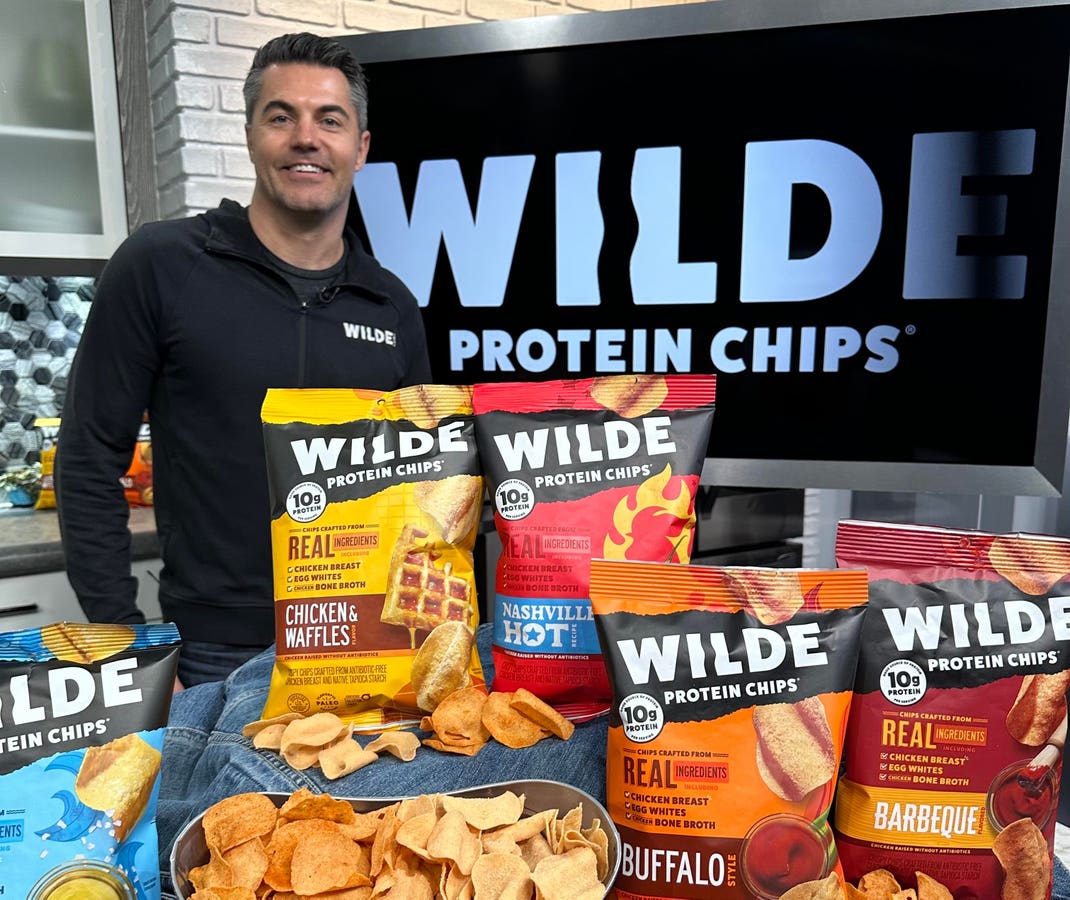Jason Wright set out to create a first-of-its kind nutrient-dense protein chip for nutrition-conscious snackers. As the founder of WILDE, he’s done just that by using chicken breast, egg whites and bone broth in a familiar chip format. I sat down with Jason to learn more about his journey with WILDE, why he chose to manufacture in his own facility in Kentucky, and what is next for the business.
Dave Knox: What exactly is WILDE, and how did the concept behind the business materialize?
Jason Wright: WILDE is not just a protein snack; it’s a revolutionary chip. While it delivers the experience of a potato chip, the primary ingredient isn’t potato—it’s chicken breast. The journey of WILDE began as a meat-centric protein bar. In 2015, I embarked on a mission to introduce what I envisioned as a protein bar resembling, say, a KIND bar. However, instead of the conventional nuts and fruits, this product would blend jerky with wholesome grains and nutritious seeds. My aim? To offer a truly healthy snack built around real food, not merely protein powder. However, this initial offering didn’t resonate with the market. By 2017, facing an underperforming business, I was grappling with disappointment and uncertainty about the company’s future. During a moment of solace with potato chips, my favorite comfort food, an epiphany struck me at the base of that chip bag: “What if I could craft a healthier alternative by replacing the potato with chicken breast?” That was the turning point. From that realization, WILDE underwent a transformative pivot—from a struggling start-up to the thriving enterprise it is today.
Knox: Transitioning from a bar to a chip is quite a dramatic pivot. What led you to contemplate this formulation, especially given the technological hurdles of venturing into uncharted territory?
Wright: Indeed, even the bar was a fresh take at the time. Several brands emerged simultaneously. During that phase, I resided in Boulder, Colorado and collaborated with Colorado State University, renowned for its expansive meat science department. We were honing the bar’s composition, and given that I was already engrossed in meat research and in collaboration with the university, the idea to shift to a chip seemed natural. I immediately sought input from the university’s experts to ideate on its feasibility. Additionally, a close friend, a proficient food scientist based in Boulder, shared invaluable insights. Our initial strategy to partner with a pork rind facility to craft the product didn’t pan out as anticipated. This challenge, however, led to an innovative solution—a proprietary technology I call the “crisper.” This custom equipment uniquely shapes and dries the product, ensuring crispiness. This innovation has been patented, and to my knowledge, the only two units are operational in Winchester, KY.
Knox: Given the patent and the distinctive technology, how do you articulate WILDE’s unique selling proposition to your customers?
Wright: We emphasize that our product boasts half the carbs of traditional potato chips yet packs five times the protein. But it’s paramount to note that this doesn’t compromise on taste or texture. The inception of WILDE was driven by my love for potato chips and the desire for a healthier alternative without losing that quintessential crispiness. Our differentiation is also accentuated by our unique flavors, drawing inspiration from classic chicken dishes—Chicken & Waffles, Nashville Hot, Buffalo, etc. These distinct offerings truly distinguish us in the snack aisle.
Knox: Walk us through the nascent stages following the shift from bar to chip. Did you approach the retailers who had previously stocked the bar? Or did you venture into direct-to-consumer sales? What was the trajectory post-pivot?
Wright: Whole Foods has consistently been our primary ally. My association with them began during the bar phase, largely because I had friends in influential positions there. Before WILDE, I had ventured into the cereal business. Although it didn’t reach the anticipated success, it was instrumental in building vital connections. I’ve always perceived Whole Foods as a benchmark—achieving success there often translated to wider market acceptance. So, for me, Whole Foods was the initial touchpoint.
As the chip gained traction, the onset of the pandemic nudged us to explore the direct-to-consumer model and platforms like Amazon. However, during the foundational period, we conducted numerous product demos at Whole Foods. These sessions were twofold: first, to discern if there was a genuine demand for a chip of this nature. The overwhelmingly positive feedback confirmed there was. Secondly, these interactions provided valuable insights into product naming. Initially, we labeled it “chicken chip.” However, market feedback steered us away from that moniker, culminating in the name “protein chip”.
Knox: Recently, you’ve made significant shifts by relocating the business to Nashville and transitioning manufacturing to Winchester, Kentucky. Share with us the rationale behind these strategic moves and the journey of partnering for manufacturing?
Wright: Certainly. Let me start by expressing my fondness for Kentucky—it’s a state with tremendous promise. Circling back to 2018, upon receiving our first proprietary, patent-pending crisper, we integrated it into our co-manufacturing process. As we navigated this partnership, it became evident that we were imparting a unique expertise to our co-manufacturer, one that was becoming the essence of WILDE’s production process. Around this juncture, a potential strategic investor approached us with a proposition: they’d invest in WILDE if we considered in-house manufacturing.
With this in mind, our search commenced in 2020. We scoured various locations, including Ohio, Indiana, and Kentucky, aiming for a central location to optimize delivery durations across the U.S. Kentucky emerged as the winner, particularly due to a fortuitous connection with a father-son duo—commercial real estate developers. Alongside the proactive support from Kentucky’s governor, we felt assured in our decision to set up in Winchester. By 2021, our facility was fully operational.
Turning to the Nashville decision, while WILDE’s origins trace back to Boulder, the demands of the Kentucky facility meant my time was increasingly spent there. The back-and-forth became arduous, prompting a re-evaluation of our headquarters’ location, especially before firming up our team. Nashville, with its vibrant energy, growing tourism–and its signature hot chicken, seemed an ideal fit. Situated a mere three hours from Lexington, it allowed proximity to our manufacturing base while tapping into the dynamism of the city. As anticipated, Nashville has proven to be a conducive environment for WILDE, and we’re excited about innovative marketing initiatives set to launch from here in 2024.
Knox: Reflecting on the evolution of WILDE, can you shed light on the strategies you’ve employed to scale? Specifically, can you provide insights into your five-year growth blueprint given the impressive trajectory you’ve charted
Wright: We’re eyeing consistent 100% year-over-year growth. Indeed, the past years have already witnessed this meteoric rise. Our emphasis is now firmly on mass retail, where our product has garnered significant acclaim, as well as expanding our presence in club stores. Central to our strategy is a robust flavor profile innovation pipeline, which draws inspiration from time-honored chicken dishes, offering a taste palette previously uncharted. Our immediate goals center on amplifying our club business, delving deeper into mass retail, and refining our flavor offerings
Knox: With flavors being a natural progression, and considering the enormity of the salty snack sector, are you intent on predominantly capitalizing on chips? Or are alternative form factors on the horizon?
Wright: Our primary objective remains dominating the chip segment. The category’s vast potential cannot be overstated. However, WILDE’s market presence varies—while we’re feature in sports nutrition in some retailers, in others we’re right amidst salty snacks. We’re convinced of WILDE chip’s potential to become a $200 million brand. While I have toyed with other form factors across categories, our focus remains undiluted. The innovation WILDE has introduced to the salty snack market is groundbreaking, and it’s crucial we maintain this momentum. It’s easy to be complacent, but we constantly remind ourselves that while we may perceive our product as familiar, to the broader market, we’re a novel sensation. Our current priority? Perfecting our chicken breast-based chips.
Knox: Given your unique entrepreneurial trajectory, including the pivot from the initial business, and WILDE’s pioneering approach with its product, what pearls of wisdom would you impart to budding entrepreneurs?
Wright: One mantra that I swear by is perseverance. Entrepreneurship is replete with challenges, with highs often followed by lows. But tenacity is key. I often liken myself to a “fruit picker”—while some days yield ripe fruits, others might bring the opposite. But the consistent effort, the relentless pursuit, is what counts. Resilience is essential. Not all endeavors will be crowned with success overnight—it’s a marathon, not a sprint. Every twist, turn, and hurdle is part of the journey. My advice? Stay the course.
Knox: Delving deeper into your insights, specifically for those entering the food sector: you highlighted the importance of owning manufacturing, a paradigm that many emerging food brands might not consider, especially when working with co-packers or commercial kitchens. What drove this conviction, and how has this decision augmented WILDE’s business model?
Wright: If WILDE were producing a mainstream product, say yogurt or cookies, I’d have possibly continued with a co-manufacturer. They bring in established equipment, allowing brands to channel their energies toward marketing and brand building. However, WILDE was treading an untrodden path. Our proprietary equipment, which was on its way to being patented, was invaluable. Our strategic investor underscored the importance of preserving our unique manufacturing “secret sauce,” advocating for in-house production.
The economic aspect was also pivotal. Working with a traditional USDA meat facility, our fee structure didn’t align well given the lightweight nature of our chips. Operating on a negative gross margin was unsustainable.
The decision to manage our manufacturing was transformational. It facilitated real-time R&D—a luxury not afforded with a co-manufacturer. Owning the facility enabled me to immerse myself in the production process, gaining invaluable insights into refining our product quality. This hands-on approach was pivotal in unlocking WILDE’s true potential.
Read the full article here





